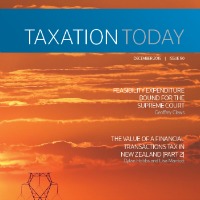Feasibility expenditure bound for Supreme Court
Article Author – Geoffrey Clews* (This article also appears in Taxation Today Issue 90.)
Earlier this year the Court of Appeal overturned the High Court’s decision in TrustPower Ltd v Commissioner of Inland Revenue [2015] NZCA 253, [2015] 3 NZLR 658. The High Court had allowed the company to deduct the costs of obtaining resource consents for what it called its “development pipeline”; however, the Court of Appeal unanimously concluded that the deduction was not available. The Court of Appeal decision has raised a number of concerns and TrustPower has successfully applied to the Supreme Court for leave to appeal on several important questions. It is hoped that the final appeal will restore some clarity to the tax treatment of feasibility expenditure.
 High Court agrees that TrustPower expenditure on resource consents is a revenue account expense
High Court agrees that TrustPower expenditure on resource consents is a revenue account expense
TrustPower is an electricity retailer. The electricity that it sells is either generated by it or purchased on the wholesale market. In order to maintain flexibility whether to generate or buy electricity in the future, TrustPower regularly sought and obtained resource consents for potential generation projects. There was, however, no assurance that any particular development project would proceed. The projects were often reassessed against each other and alongside the option of continuing to purchase electricity for onward supply. TrustPower considered that the expenditure was revenue expenditure, incurred in the course of deriving income from the generation and/or sale of electricity.
The High Court agreed, concluding that obtaining the resource consents was a crucial and integral part of TrustPower’s business and so should be treated as a revenue account expense. It was widely anticipated that the High Court’s decision would be appealed by the Commissioner given its potential impact in other areas. An appeal to the Court of Appeal followed and its decision given on 19 June 2015.
Commissioner appeals High Court decision
The Court allowed the Commissioner’s appeal, finding that the disputed expenditure was incurred on capital account but also holding that the requisite nexus between incurring the expenditure and deriving income (or conducting a business to that end) was not established. In doing that the Court chose not to reflect Inland Revenue’s practice statement in relation to feasibility expenditure. Broadly speaking, that draws a distinction between expenditure incurred prior to and after definitive commitment to a project, allowing deduction of the former and requiring capitalisation and depreciation of the latter. Under that approach much of what TrustPower had expended on feasibility was allowed as a deduction. The costs of resource consents had been carved out by Inland Revenue for different treatment on the basis that they were stand-alone assets; something which the High Court had concluded was not the case. The practice statement distinction provided a fairly readily applied demarcation for tax purposes over which the Court of Appeal’s decision has cast a cloud of uncertainty.
Court concludes expenditure not deductible
the Court of Appeal opened up potentially far reaching consequences, not least the risk that if feasibility expenditure is of a capital nature it may be both non-deductible and non-depreciable
The Court dismissed the Commissioner’s argument that because the resource consents were “depreciable intangible property” for the purposes of the Income Tax Act 2007, the expenditure incurred for those consents was on capital account. Instead, it held that the characterisation of the expenditure for capital/revenue purposes needed to be considered first. The Court went on to apply general capital/revenue principles and reached the conclusion that the expenditure was on capital account and was therefore not deductible.
In reaching this conclusion the Court considerably overreached the submissions made by the Crown. Importantly, the Crown’s argument had recognised that the expenditure incurred by TrustPower had a connection with the conduct of its business so that the requirements of the general permission in s DA 1 of the Income Tax Act 2007 were met. It had sought to rule out a deduction on the basis of the capital limitation in s DA 2. By finding that the company did not even meet the requirements of the general permission, the Court of Appeal opened up potentially far reaching consequences, not least the risk that if feasibility expenditure is of a capital nature it may be both non-deductible and non-depreciable. This was quite contrary to the practice of Inland Revenue referred to above and, if correct, represents a significant narrowing of expectations for the tax treatment of feasibility expenditure.
Even if an s DA 1 nexus had been acknowledged, it is clear that the Court of Appeal would have concluded that the capital limitation prevented a deduction for the costs of the resource consents. The Court’s primary objection to deductibility appears to have been that the object of the expenditure was inevitably capital. It considered that TrustPower’s “development pipeline” (which contains at least 200 projects at any time) was the means of determining the viability, feasibility and costs of building new generation capacity. This can be contrasted with the basic premise advanced by the company, which was that the object of the expenditure was to determine which of the build or buy options that were before it should be pursued at any given time. Having framed the object of the expenditure in terms of building capacity, it followed that new generation capacity involved extending the business organisation and that such an extension or expansion of the business structure was typically capital.
Perplexities arising from the approach
This approach has the arguable attraction of simplicity but on a number of levels is perplexing. It assumes that the expenditure on consents had no object or purpose apart from the construction of new generating plants and so the costs were necessarily outlaid on a matter of capital. However, there was never any certainty that the projects would be carried into existence. In a recent paper this writer styled them as “castles on a cloud”, which might or might not solidify as time and options progress.
A classic test for determining the tax character of expenditure is to identify what, from a commercial and practical point of view, the expenditure is intended to bring about. The company evidence, which was unchallenged at first instance, was that the expenditure was outlaid to allow a continuing assessment to be made of whether to build capacity or buy electricity. The Court of Appeal’s construct of the objective for which the “pipeline” existed ignored that comparative assessment of options and attributed the expenditure only to the possibility of expanding generating capacity, whether or not that was actually ever undertaken.
The Court held that it need not decide whether the consents were capital assets themselves because of its view that they were acquired with a view to capital expansion.
The consequences of the Court's decision
The sums at stake for TrustPower are considerable and a further appeal was inevitable. Quite apart from that, the uncertainty that the Court of Appeal’s decision has left in its wake demanded further consideration of its findings. The questions for which the Supreme Court has given leave to appeal signal the areas where it considers there is a need for the case to be considered further. They highlight the aspects of the Court of Appeal’s approach which have been the subject of criticism.
Areas the Supreme Court will address
Did the Court of Appeal overreach itself?
First, the Supreme Court has permitted the appeal to address whether the Court of Appeal should have dismissed as irrelevant the basis on which Inland Revenue had assessed. Related to that, it will hear argument on whether the Court exceeded its jurisdiction in dealing with the case as it did, and in particular whether the finding that TrustPower did not satisfy the general permission in s DA 1 of the Income Tax Act 2007 is correct. This is the chance to conclude whether indeed the Court of Appeal overreached in denying a deduction.
Was there sufficient evidential basis to the Court of Appeal conclusions?
Secondly, the Supreme Court will consider the criticisms that have been made that the Court of Appeal came to conclusions for which there was no evidential basis. There is no doubt that the Court chose to reconsider the weight that should be given to the evidence of the company, but there are some conclusions that seem to ignore that evidence or to dismiss it when contrary evidential foundation was not laid by the Commissioner at first instance. This is an important matter because traditionally the extent to which an appellate court will revisit matters of evidence has been limited. Even though an appeal is supposed to be a de novo consideration of the issues, that consideration should have regard to the record of the evidence produced at first instance. It will be instructive to understand just how far an appellate court can go in putting a different slant on evidence that has arguably not been challenged in the court below.
What way should the capital or revenue nature of feasibility be determined?
Thirdly, the Supreme Court has permitted argument which might hopefully elicit some greater clarity about the way the capital or revenue nature of feasibility expenditure should be determined. And lastly, related to the third topic, there is a question which picks up the distinction in the Inland Revenue practice note and will directly test its relevance. It asks whether the Commissioner was correct to have concluded that the decision to apply for a resource consent meant that the expenditure which followed was sufficiently connected with a capital project to be on capital account.
The dangers of predicting the outcome
It is always difficult and potentially dangerous to try to predict the outcome of an appeal. Even if the Supreme Court eventually acknowledges that TrustPower’s expenditure was outlaid for an object which included the “build or buy” comparative costing process, and which might suggest revenue account treatment, it may well conclude that the consents were valuable assets in and of themselves, capable of being turned to capital account at the company’s choice so that the costs of acquiring them should nevertheless be non-deductible. That would be contrary to the findings of the High Court, but if the nature of the consents is considered to be a matter of law and not fact, the Supreme Court may well claim the latitude to reach a different conclusion while respecting the primacy of the High Court as the trier of fact.
 * Article author Mr Geoffrey Clews practices from Old South British Chambers as specialist tax and trusts counsel in Auckland. He acknowledges the assistance of his Barrister associate Sam Davies in the preparation of this article.
* Article author Mr Geoffrey Clews practices from Old South British Chambers as specialist tax and trusts counsel in Auckland. He acknowledges the assistance of his Barrister associate Sam Davies in the preparation of this article.
 More tax and accounting information
More tax and accounting information
- To read similar articles on a regular basis find out more about the magazine Taxation Today
- To see how our tax and accounting product Checkpoint might benefit you please call: 0800 10 6060 to talk to a member of our customer care team.